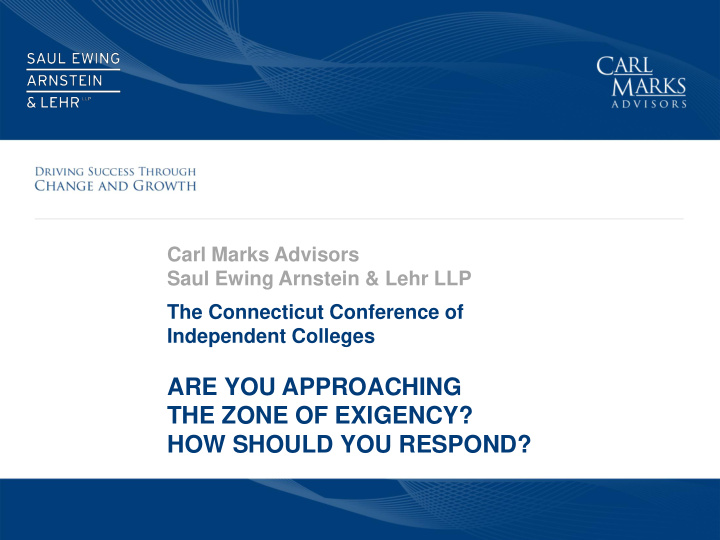



Carl Marks Advisors Saul Ewing Arnstein & Lehr LLP The Connecticut Conference of Independent Colleges ARE YOU APPROACHING THE ZONE OF EXIGENCY? HOW SHOULD YOU RESPOND?
What is “Financial Exigency”? • Concept adopted by the American Association of University Professors (“AAUP”). • Allows college to take unique and drastic steps to alleviate a financial crisis, such as terminating tenured faculty members, eliminating programs, etc. • An “imminent financial crisis which threatens the survival of the institution as a whole”. • But how do you know if you are actually there? 2
Approaching the Zone of Exigency The “Zone of Exigency” is the point at which an institution evaluates its ability to meet its financial obligations in the upcoming year. If an institution approaches this zone, some level of restructuring is required that will allow the institution to survive and regroup. • Every institution is now facing financial issues connected with students, education, health, operations and human resources that require immediate and long term solutions • Enrollment, housing and donations are all concerns that will impact the financial health of the institution • Time is not your ally. Waiting to see what happens is not an option • Institutions have limited resources and the experience necessary for evaluating numerous restructuring scenarios which will delay decisions with the precious little time remaining The immediate concern is meeting the financial and education obligations of the institution. Putting in place the process for change must be met with the same urgency. 3
Areas for Improvement – Restructuring for the Future Embrace the Process ▪ Leadership through Transparency to Achieve Buy-in ▪ Budgeting, Liquidity Forecasts and Financial Projections ▪ Business Plan Review and Development ▪ Business Plan Rationalization and Revitalization ▪ The Growth Mindset » Evaluation of Portfolio » Focus on the Market ▪ Cost-Performance Assessment ▪ Stakeholder Communications ▪ Lender Negotiations ▪ Regulatory Compliance 4
Factors for Success • Implement change from the top with complete senior leadership buy in • President must actively engage the Board • Provide transparency and include all stakeholders in the change process • Leverage expertise and affirm commitment to the goals • Utilize strong analytics in decision making • Implement the process with a bottom up budget approach • Include all stakeholder viewpoints – Academic, Student/Family, Alumni, Faculty, Administration and Community • Limit impact on student experience by focusing on all dimensions of the university – education, operations, administration and business management • Lead change with a “Hands On” approach with shared responsibility • Emphasize financial urgency while insisting on strong accountability • Incorporate financial, liquidity and risk dynamics into operating plans and restructuring • Engage and Collaborate with Donors and Alumni to create a partnership • Maintain regulatory and accreditation standards • Short term success will build long term sustainability 5
Other Strategic Possibilities When Approaching the Zone of Exigency • Merger. • Rebranding. • Actually declaring financial exigency. • Closure/workout. 6
Declaring Exigency – Legal Considerations - AAUP • Not “bound” by AAUP regulations. But following them provides authority for taking unique steps as noted (terminating faculty w/o cause, eliminating programs, etc.). • Not legal immunity, to be clear. • AAUP suggests that: • No less drastic means must be available. • Faculty should participate in decision that a financial exigency exists. • Faculty should have primary responsibility for deciding where terminations (individuals/programs) should occur. • Any tenured faculty to be terminated get a hearing to explain why they should not be terminated; institution should prove legitimacy of exigency and necessity of termination. • Don’t terminate tenured faculty in favor of (cheaper) non -tenured faculty. • One year notice or severance, “recall rights” (no replacement for 3 years). • These are AAUP regulations. They do not bind you (although you may have adopted in your Bylaws). But if you adopt AAUP definition of exigency to terminate, be mindful of these other AAUP guidelines. • In 2004, AAUP issued a report – we think that only 4 out of 28 declarations of exigency (as of that date) were legitimate. 7
Accreditation Considerations – New England Commission on Higher Education • Substantive changes to your institution should be run past NECHE, ideally in advance. These include: • Merger / change of control • Acquisition • Dropping or reducing programs to extent that your mission is not being accomplished. • “Changing the overall financial position of the institution through actions such as assumption of debt … or other significant financial restructuring that reduces the ability of the institution to independently meet the Standards for Accreditation .” • Goal is to get pre-approval. • If do not get approval from NECHE, and move forward anyway with changes, risk accreditation. If winding down institution entirely or eliminating programs is the decision, will need to enact a teach-out plan. • Allows impacted students to proceed to graduation. 8
Possible Litigation • Alumni • Students • Faculty • Unions (if CBA) 9
Other Legal Considerations • Federal financial aid. • Possibility of Heightened Cash Monitoring. • HCM1 vs. HCM2. • Can exacerbate cash flow problems. • Donors / endowed funds. • If change to use of charitable funds, need to loop in the AG. • Connecticut General Statutes §45a-514 (Statute of Charitable Trusts) and Connecticut General Statutes §47-2 (Statute of Charitable Uses) are specific to charitable trusts and uses and require that all gifts given for charitable purposes be used exclusively for the purposes for which they were raised. 10
Questions?? Steven Agran, CTP, CIRA James A. Keller, Esq. Carl Marks Advisors Saul Ewing Arnstein & Lehr LLP Managing Director Chair, Higher Education Practice 212-909-8448 office 215-972-1964 office 917-865-4716 cell 215-200-7712 cell sagran@carlmarks.com James.Keller@saul.com 11
Recommend
More recommend